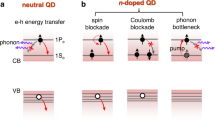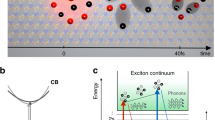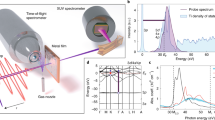Abstract
Carrier relaxation is a key issue in determining the efficiency of semiconductor optoelectronic device operation. Devices incorporating semiconductor quantum dots have the potential to overcome many of the limitations of quantum-well-based devices because of the predicted long quantum-dot excited-state lifetimes. For example, the population inversion required for terahertz laser operation in quantum-well-based devices (quantum-cascade lasers1,2) is fundamentally limited by efficient scattering between the laser levels, which form a continuum in the plane of the quantum well. In this context, semiconductor quantum dots are a highly attractive alternative for terahertz devices, because of their intrinsic discrete energy levels. Here, we present the first measurements, and theoretical description, of the intersublevel carrier relaxation in quantum dots for transition energies in the few terahertz range. Long intradot relaxation times (1.5 ns) are found for level separations of 14 meV (3.4 THz), decreasing very strongly to ∼2 ps at 30 meV (7 THz), in very good agreement with our microscopic theory of the carrier relaxation process. Our studies pave the way for quantum-dot terahertz device development, providing the fundamental knowledge of carrier relaxation times required for optimum device design.
This is a preview of subscription content, access via your institution
Access options
Subscribe to this journal
Receive 12 print issues and online access
$259.00 per year
only $21.58 per issue
Buy this article
- Purchase on Springer Link
- Instant access to full article PDF
Prices may be subject to local taxes which are calculated during checkout



Similar content being viewed by others
References
Faist, J. et al. Quantum cascade laser. Science 264, 553–556 (1994).
Kohler, R. et al. Terahertz semiconductor-heterostructure laser. Nature 417, 156–159 (2002).
Urayama, J., Norris, T. B., Singh, J. & Bhattacharya, P. Observation of phonon bottleneck in quantum dot electronic relaxation. Phys. Rev. Lett. 86, 4930–4933 (2001).
Borri, P. & Langbein, W. Four-wave mixing dynamics of excitons in InGaAs self-assembled quantum dots. J. Phys. Condens. Matter 19, 295201 (2007).
Botez, D. et al. Progress towards intersubband quantum-box lasers for highly efficient continuous wave operation in the mid-infrared. J. Nanophoton. 3, 031606 (2009).
Murdin, B. N. et al. Direct observation of the LO phonon bottleneck in wide GaAs/AlxGa1−x As quantum wells. Phys. Rev. B 55, 5171–5176 (1997).
Hartig, M. et al. Efficient intersubband scattering via carrier–carrier interaction in quantum wells. Phys. Rev. Lett. 80, 1940–1943 (1998).
Wade, A. et al. Magnetic-field-assisted terahertz quantum cascade laser operating up to 225 K. Nature Photon. 3, 41–45 (2008).
Sauvage, S. et al. Long polaron lifetime in InAs/GaAs self-assembled quantum dots. Phys. Rev. Lett. 88, 177402 (2002).
Zibik, E. A. et al. Intraband relaxation via polaron decay in InAs self-assembled quantum dots. Phys. Rev. B 70, 161305(R) (2004).
Li, X.-Q., Nakayama, H. & Arakawa, Y. Phonon bottleneck in quantum dots: Role of lifetime of the confined optical phonons. Phys. Rev. B 59, 5069–5073 (1999).
Verzelen, O., Ferreira, R. & Bastard, G. Polaron lifetime and energy relaxation in semiconductor quantum dots. Phys. Rev. B 62, 4809–4812(R) (2000).
Grange, T., Ferreira, R. & Bastard, G. Polaron relaxation in self-assembled quantum dots: Breakdown of the semiclassical model. Phys. Rev. B 76, 241304(R) (2007).
Nabetani, Y. et al. Initial growth stage and optical properties of a three-dimensional InAs structure on GaAs. J. Appl. Phys. 76, 347–351 (1994).
Stier, O. et al. Electronic and optical properties of strained quantum dots modeled by 8-band k.p theory. Phys. Rev. B 59, 5688–5701 (1999).
Bester, G. et al. Pseudopotential calculation of the excitonic fine structure of million-atom self-assembled In1−xGaxAs/GaAs quantum dots. Phys. Rev. B 67, 161306 (2003).
Fafard, S. et al. Manipulating the energy levels of semiconductor quantum dots. Phys. Rev. B 59, 15368–15373 (1999).
Fafard, S. & Allen, C. Nì. Intermixing in quantum-dot ensembles with sharp adjustable shells. Appl. Phys. Lett. 75, 2374–2376 (1999).
Zibik, E. A. et al. Effects of alloy intermixing on the lateral confinement potential in InAs/GaAs self-assembled quantum dots probed by intersublevel absorption spectroscopy. Appl. Phys. Lett. 90, 163107 (2007).
Lehnert, U. et al. Proc. 29th FEL Conference, Novosibirsk, Russia (2007); available at <http://accelconf.web.cern.ch/AccelConf/f07/PAPERS/MOPPH036.PDF>.
Bockelman, U. & Bastard, G. Phonon scattering and energy relaxation in two-, one-, and zero-dimensional electron gases. Phys. Rev. B 42, 8947–8951 (1990).
Benisty, H., Sotomayor-Torres, C. M. & Weisbuch, C. Intrinsic mechanism for the poor luminescence properties of quantum-box systems. Phys. Rev. B 44, 10945–10948 (1991).
Inoshita, T. & Sakaki, H. Density of states and phonon-induced relaxation of electrons in semiconductor quantum dots. Phys. Rev. B 56, R4355–R4358 (1997).
Hameau, S. et al. Strong electron–phonon coupling regime in quantum dots: Evidence for everlasting resonant polarons. Phys. Rev. Lett. 83, 4152–4155 (1999).
Carpenter, B. A. et al. Intraband magnetospectroscopy of singly and doubly charged n-type self-assembled quantum dots. Phys. Rev. B 74, 161302(R) (2006).
Garcia, C. P. et al. Evidence of correlation in spin excitations of few-electron quantum dots. Phys. Rev. Lett. 95, 266806 (2005).
Fujisawa, T. et al. Allowed and forbidden transitions in artificial hydrogen and helium atoms. Nature 419, 278–281 (2002).
Acknowledgements
Financial support was provided by the UK Engineering and Physical Sciences Research Council (EPSRC). The LPA (UMR 8551) is associated with the CNRS and the Universities Paris 6 and Paris 7. The free-electron laser ‘FELBE’ is supported by the Integrating Activity on Synchrotron and Free-Electron Laser Science (IA-SFS) under the EU contract RII3-CT-2004-506008 of the 6th Framework ‘Structuring the European Research Area, Research Infrastructures Action’. We are grateful to P. Michel and the FELBE team for their dedicated support.
Author information
Authors and Affiliations
Contributions
E.A.Z. and L.R.W. conceived the experiments; E.A.Z., L.R.W., B.A.C., N.E.P., D.S. and S.W. carried out the experiments; T.G., R.F. and G.B. made the theory and modelled the experiments; E.A.Z. and T.G. analysed the data; L.R.W., R.F., E.A.Z. and M.S.S. supervised the project; H.Y.L. grew the samples; T.G., E.A.Z., R.F. and L.R.W. wrote the paper with major input and edits from M.S.S. and M.H. All authors discussed the results and commented on the manuscript.
Corresponding authors
Supplementary information
Supplementary Information
Supplementary Information (PDF 267 kb)
Rights and permissions
About this article
Cite this article
Zibik, E., Grange, T., Carpenter, B. et al. Long lifetimes of quantum-dot intersublevel transitions in the terahertz range. Nature Mater 8, 803–807 (2009). https://doi.org/10.1038/nmat2511
Received:
Accepted:
Published:
Issue Date:
DOI: https://doi.org/10.1038/nmat2511
This article is cited by
-
Coherent control of a high-orbital hole in a semiconductor quantum dot
Nature Nanotechnology (2023)
-
Modeling electronic and optical properties of III–V quantum dots—selected recent developments
Light: Science & Applications (2022)
-
Optically driving the radiative Auger transition
Nature Communications (2021)
-
Biosynthesis of inorganic nanomaterials using microbial cells and bacteriophages
Nature Reviews Chemistry (2020)
-
Terahertz Selective Emission Enhancement from a Metasurface-Coupled Photoconductive Emitter in Quasi-Near-Field Zone
Plasmonics (2020)



